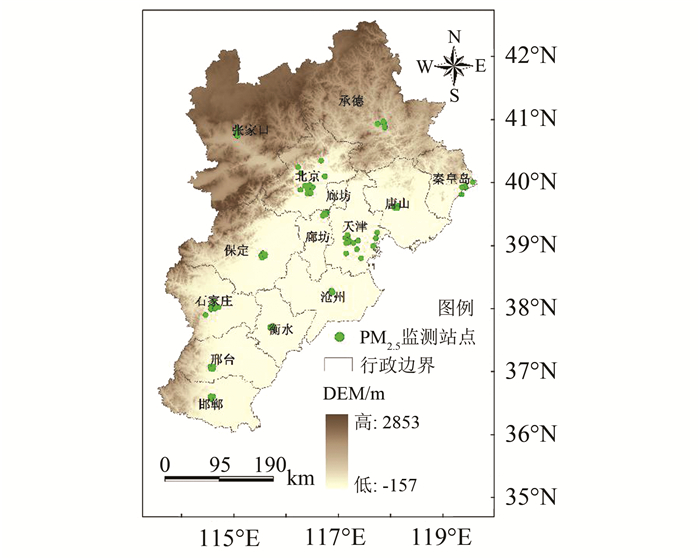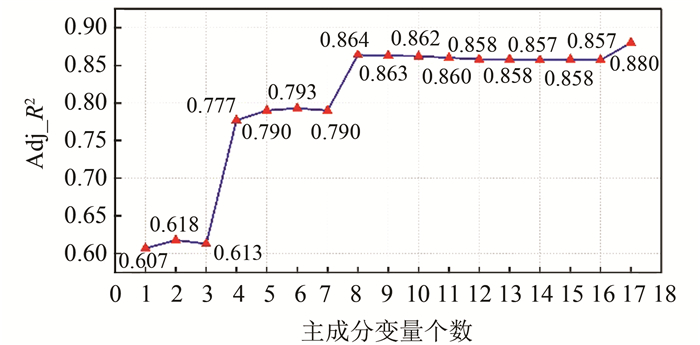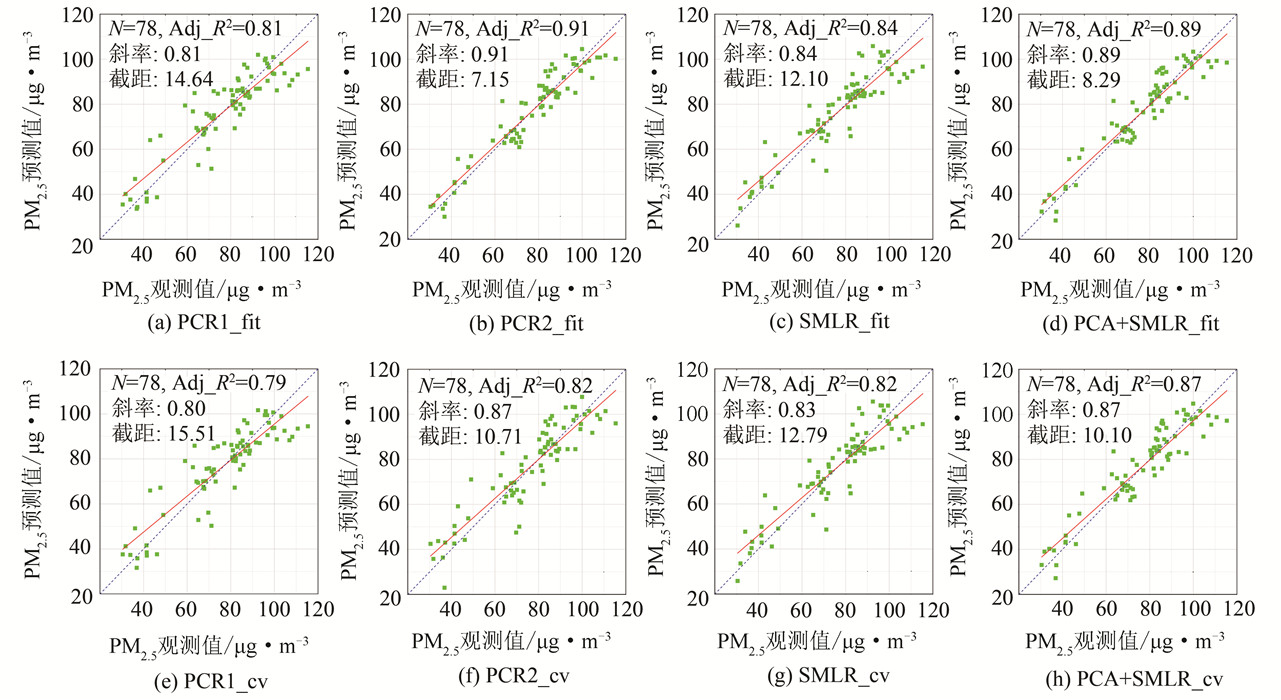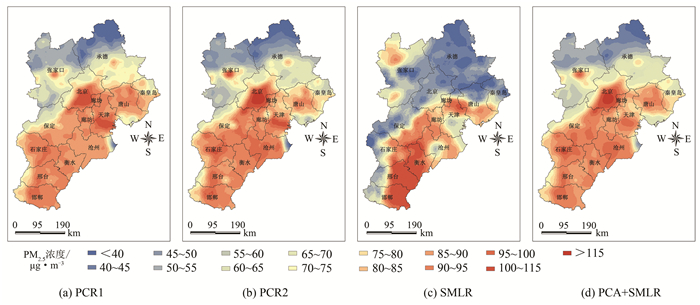An Improved LUR-based Spatial Distribution Simulation for the Large Area PM2.5 Concentration
-
摘要: 针对采用传统土地利用回归(land use regression,LUR)模型进行大气污染物浓度模拟时预测变量信息损失的缺陷,将主成分分析(principle component analysis,PCA)与逐步多元线性回归(stepwise multiple line regression,SMLR)相结合,提出了一种改进的LUR(PCA+SMLR)模型模拟大区域PM2.5浓度空间分布的方法。首先采用相关分析筛选与PM2.5显著相关的预测变量,然后对筛选出的预测变量进行主成分变换(PCA),最后保留所有主成分变量进行SMLR建立回归模型模拟PM2.5浓度。并以京津冀为研究区域进行实验验证,对PCR、SMLR、PCA+SMLR这3种模型的实验结果进行对比分析,结果表明,PCA+SMLR模型可提高预测变量对回归模型的贡献度,调整后R2达0.883,并且其精度检验指标及制图效果皆优于传统的LUR模型,证明了该模型可有效提高PM2.5浓度的模拟精度,对PM2.5区域联防联控具有指导意义。Abstract: There exists the shortage of traditional land use regression (LUR) model in losing information of predictor variables when simulating the air pollutant concentration. An improved model which combined principal component regression (PCR) and stepwise multiple line regression (SMLR)-LUR (PCA+SMLR) was developed to simulate the spatial distribution of PM2.5 in large area. Firstly, the correlation analysis was conducted to screen out effective predictor variables. Secondly, principal component analysis (PCA) was employed to transform effective predictor variables to principle components. Finally, all principal components were used to conduct SMLR to simulate the spatial distribution of PM2.5. Meanwhile, the reliability of the improved model was tested in Beijing-Tianjin-Hebei urban agglomeration. Experimental results of three models (PCR, SMLR and PCA+SMLR) were compared and analyzed. The results indicated that the PCA+SMLR model has an adjusted R2 of 0.883 by improving the contribution of the predictor variables. Besides, it is better than the traditional mo-del for accuracy index and the mapping results. Therefore, it can be concluded that the PCA+SMLR is a promising PM2.5 modeling method and could be very use-ful for air pollution mapping.
-
Keywords:
- PM2.5 /
- PCA /
- SMLR /
- contribution /
- spatial distribution
-
-
表 1 模型参数及拟合度对比结果
Table 1 Comparison of Parameterization and Model Fitting for Four Models
模型 参数 Adj_R2 PCR1 P1、P2、P3、P4、P5、P6 0.793 PCR2 P1、P2、P3、P4、P5、P6、P7、P8、P9、
P10、P11、P12、P13、P14、P15、P16、P170.880 SMLR X1、X2、X3、X4、X5 0.832 PCA+SMLR P1、P2、P4、P5、P8、P17 0.883 注:Pi为第i个主成分;X1为气溶胶光学厚度;X2为降水;X3为监测站8 000 m缓冲区内耕地面积占比;X4为监测站8 000 m缓冲区内房屋建筑面积占比;X5为监测站5 000 m缓冲区内的露天采掘场面积占比。 表 2 精度检验指标对比结果
Table 2 Comparison of Accuracy Indicators for Four Models
模型 拟合精度 验证精度 RMSE
/μg·m-3MPE
/μg·m-3MRPE
/%RMSE
/μg·m-3MPE
/μg·m-3MRPE
/%PCR1 8.942 6.869 9.920 10.394 7.102 9.300 PCR2 6.248 5.000 6.983 8.780 6.950 10.266 SMLR 8.104 6.225 8.628 9.303 6.628 8.509 PCA+SMLR 6.721 5.278 7.389 7.391 5.912 8.419 -
[1] Zou B, Pu Q, Bilal M, et al. High-Resolution Sate-llite Mapping of Fine Particulates Based on Geographically Weighted Regression[J].IEEE Geoscience and Remote Sensing Letters, 2016, 13(4):495-499 doi: 10.1109/LGRS.2016.2520480
[2] Silva R A, West J J, Zhang Y, et al. Global Premature Mortality Due to Anthropogenic Outdoor Air Pollution and the Contribution of Past Climate Change[J].Environmental Research Letters, 2013, 8(3):034005 doi: 10.1088/1748-9326/8/3/034005
[3] Lim J M, Jeong J H, Lee J H, et al. The Analysis of PM2.5 and Associated Elements and Their Indoor/Outdoor Pollution Status in an Urban Area[J]. Indoor Air, 2011, 21(2):145-155 doi: 10.1111/ina.2011.21.issue-2
[4] 邹滨, 许珊, 张静.融合空间尺度特征的时空序列预测建模方法[J].武汉大学学报·信息科学版, 2017, 42(2):216-222 http://ch.whu.edu.cn/CN/abstract/abstract3391.shtml Zou Bin, Xu Shan, Zhang Jin. Spatial Variation Analysis of Urban Air Pollution Using GIS:A Land Use Perspective[J].Geomatics and Information Science of Wuhan University, 2017, 42(2):216-222 http://ch.whu.edu.cn/CN/abstract/abstract3391.shtml
[5] 邓敏, 陈倜, 杨文涛.融合空间尺度特征的时空序列预测建模方法[J].武汉大学学报·信息科学版, 2015, 40(12):1625-1632 http://ch.whu.edu.cn/CN/abstract/abstract3391.shtml Deng Min, Chen Ti, Yang Wentao. A New Method of Modeling Spatio-temporal Sequence by Conside-ring Spatial Characteristics[J]. Geomatics and Information Science of Wuhan University, 2015, 40(12):1625-1632 http://ch.whu.edu.cn/CN/abstract/abstract3391.shtml
[6] Zou B, Luo Y, Wan N, et al. Performance Compari-son of LUR and OK in PM2.5 Concentration Mapping:A Multidimensional Perspective[J]. Sci Rep, 2015, 5(5):8698
[7] Briggs D J, Collins S, Elliott P, et al. Mapping Urban Air Pollution Using GIS:A Regression-based Approach[J]. International Journal of Geographi-cal Information Science, 1997, 11(7):699-718 doi: 10.1080/136588197242158
[8] 焦利民, 许刚, 赵素丽, 等.基于LUR的武汉市PM2.5浓度空间分布模拟[J].武汉大学学报·信息科学版, 2015, 40(8):1088-1094 http://ch.whu.edu.cn/CN/abstract/abstract3417.shtml Jiao Limin, Xu Gang, Zhao Suli, et al. LUR-based Simulation of the Spatial Distribution of PM2.5 of Wuhan[J]. Geomatics and Information Science of Wuhan University, 2015, 40(8):1088-1094 http://ch.whu.edu.cn/CN/abstract/abstract3417.shtml
[9] Zou B, Xu S, Sternberg T, et al. Effect of Land Use and Cover Change on Air Quality in Urban Sprawl[J].Sustainability, 2016, 8(7):677 doi: 10.3390/su8070677
[10] Olvera H A, Garcia M, Li W W, et al. Principal Component Analysis Optimization of a PM2.5 Land Use Regression Model with Small Monitoring Network[J]. Sci Total Environ, 2012, 425:27-34 doi: 10.1016/j.scitotenv.2012.02.068
[11] Ul-Saufie A Z, Yahaya A S, Ramli N A, et al. Future Daily PM10 Concentrations Prediction by Combining Regression Models and Feedforward Backpropagation Models with Principle Component Analysis (PCA)[J]. Atmospheric Environment, 2013, 77:621-630 doi: 10.1016/j.atmosenv.2013.05.017
[12] Li S, Zhai L, Zou B, et al. A Generalized Additive Model Combining Principal Component Analysis for PM2.5 Concentration Estimation[J]. ISPRS International Journal of Geo-Information, 2017, 6:248 doi: 10.3390/ijgi6080248
[13] Ghosh D, Manson S M. Robust Principal Component Analysis and Geographically Weighted Regression Urbanization in the Twin Cities Metropolitan Area of Minnesota[J].J Urban Reg Inf Syst Assoc, 2008, 20(1):15-25 https://www.researchgate.net/publication/243970515_Robust_Principal_Component_Analysis_and_Geographically_Weighted_Regression_Urbanization_in_the_Twin_Cities_Metropolitan_Area_of_Minnesota
[14] 朱建平, 殷瑞飞. SPSS在统计分析中的应用[D].北京: 清华大学出版社, 2007 Zhu Jianping, Yin Ruifei. Application of SPSS in Statistical Analysis[D].Beijing: Tsinghua University Press, 2007
[15] 郑咏梅, 张军, 陈星旦, 等.基于逐步回归法的近红外光谱信息提取及模型的研究[J].光谱学与光谱分析, 2004, 24(6):675-678 doi: 10.3321/j.issn:1000-0593.2004.06.010 Zheng Yongmei, Zhang Jun, Chen Xingdan, et al.Reasearch on Model and Wavelength Selection of Near Infrared Spectral Information[J].Spectrosc Spect Anal, 2004, 24(6):675-678 doi: 10.3321/j.issn:1000-0593.2004.06.010
[16] Zhai L, Zou B, Fang X, et al. Land Use Regression Modeling of PM2.5 Concentrations at Optimized Spatial Scales[J]. Atmosphere, 2017, 8(1):1-15 https://www.researchgate.net/publication/311880812_Land_Use_Regression_Modeling_of_PM25_Concentrations_at_Optimized_Spatial_Scales
[17] Fang X, Zou B, Liu X, et al. Satellite-based Ground PM2.5 Estimation Using Timely Structure Adaptive Modeling[J]. Remote Sensing of Environment, 2016, 186:152-163 doi: 10.1016/j.rse.2016.08.027
[18] Rodriguez J D, Perez A, Lozano J A. Sensitivity Analysis of Kappa-fold Cross Validation in Prediction Error Estimation[J].IEEE Trans Pattern Anal Mach Intell, 2010, 32(3):569-575 doi: 10.1109/TPAMI.2009.187
[19] Olvera H A, Garrcia M, Li W W, et al. Principal Component Analysis Optimization of a PM2.5 Land Use Regression Model with Small Monitoring Network[J]. Science of the Environment, 2012, 425(3):27-34 https://www.ncbi.nlm.nih.gov/pubmed/22464030
-
期刊类型引用(3)
1. 周永章,陈川,张旗,王功文,肖凡,沈文杰,卞静,王亚,杨威,焦守涛,刘艳鹏,韩枫. 地质大数据分析的若干工具与应用. 大地构造与成矿学. 2020(02): 173-182 .  百度学术
百度学术
2. 王叶晨梓,杜震洪,张丰,刘仁义. 面向分片地图的多分辨率格点数据统一存取方法. 浙江大学学报(理学版). 2017(05): 584-590 .  百度学术
百度学术
3. 朱建章,石强,陈凤娥,史晓丹,董泽民,秦前清. 遥感大数据研究现状与发展趋势. 中国图象图形学报. 2016(11): 1425-1439 .  百度学术
百度学术
其他类型引用(6)





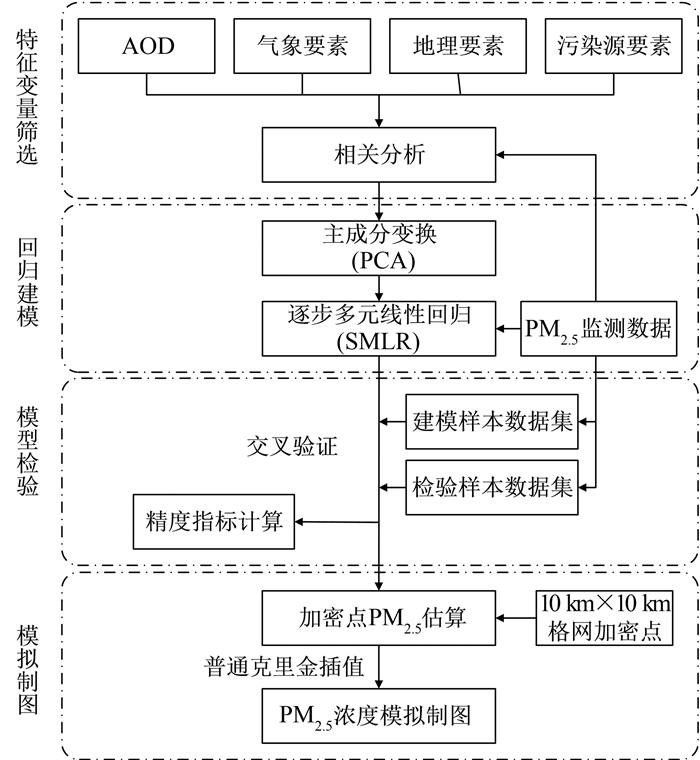
 下载:
下载:
